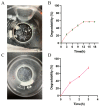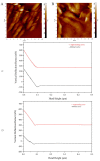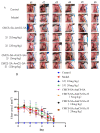Carboxymethyl Chitosan/Sodium Alginate/Chitosan Quaternary Ammonium Salt Composite Hydrogel Supported 3J for the Treatment of Oral Ulcer
- PMID: 37623114
- PMCID: PMC10454119
- DOI: 10.3390/gels9080659
Carboxymethyl Chitosan/Sodium Alginate/Chitosan Quaternary Ammonium Salt Composite Hydrogel Supported 3J for the Treatment of Oral Ulcer
Abstract
Oral ulcer is a common inflammatory disease of oral mucosa, causing severe burning pain and great inconvenience to daily life. In this study, compound 3J with anti-inflammatory activity was synthesized beforehand. Following that, an intelligent composite hydrogel supported 3J was designed with sodium alginate, carboxymethyl chitosan, and chitosan quaternary ammonium salt as the skeleton, and its therapeutic effect on the rat oral ulcer model was investigated. The results show that the composite hydrogel has a dense honeycomb structure, which is conducive to drug loading and wound ventilation, and has biodegradability. It has certain antibacterial effects and good anti-inflammatory activity. When loaded with 3J, it reduced levels of TNF-α and IL-6 in inflammatory cells by up to 50.0%. It has excellent swelling and water retention properties, with a swelling rate of up to 765.0% in a pH 8.5 environment. The existence of a large number of quaternary ammonium groups, carboxyl groups, and hydroxyl groups makes it show obvious differences in swelling in different pH environments, which proves that it has double pH sensitivity. It is beneficial to adapt to the highly dynamic changes of the oral environment. Compared with single hydrogel or drug treatment, the drug-loaded hydrogel has a better effect on the treatment of oral ulcers.
Keywords: carboxymethyl chitosan; chitosan quaternary ammonium salt; hydrogel; oral ulcer; sodium alginate.
Conflict of interest statement
The authors declare no conflict of interest.
Figures













Similar articles
-
Preparation of Cross-linked Chitosan Quaternary Ammonium Salt Hydrogel Films Loading Drug of Gentamicin Sulfate for Antibacterial Wound Dressing.Mar Drugs. 2021 Aug 25;19(9):479. doi: 10.3390/md19090479. Mar Drugs. 2021. PMID: 34564141 Free PMC article.
-
Facile synthesis of pH-responsive sodium alginate/carboxymethyl chitosan hydrogel beads promoted by hydrogen bond.Carbohydr Polym. 2022 Feb 15;278:118993. doi: 10.1016/j.carbpol.2021.118993. Epub 2021 Dec 10. Carbohydr Polym. 2022. PMID: 34973796
-
Chitosan quaternary ammonium salt-oxidized sodium alginate-glycerol-calcium ion biobased self-healing hydrogels with excellent spontaneous repair performance.RSC Adv. 2024 Oct 8;14(43):31954-31965. doi: 10.1039/d4ra05382f. eCollection 2024 Oct 1. RSC Adv. 2024. PMID: 39380645 Free PMC article.
-
A novel pH-sensitive hydrogel composed of N,O-carboxymethyl chitosan and alginate cross-linked by genipin for protein drug delivery.J Control Release. 2004 Apr 28;96(2):285-300. doi: 10.1016/j.jconrel.2004.02.002. J Control Release. 2004. PMID: 15081219
-
Preparation and characterization of carboxymethyl cellulose containing quaternized chitosan for potential drug carrier.Int J Biol Macromol. 2020 Jul 1;154:1392-1399. doi: 10.1016/j.ijbiomac.2019.11.019. Epub 2019 Nov 12. Int J Biol Macromol. 2020. PMID: 31730962
References
Grants and funding
LinkOut - more resources
Full Text Sources

